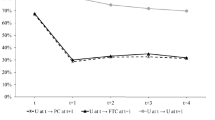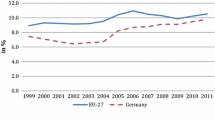Abstract
It is widely accepted that temporary jobs tend to be associated with low pay which, in turn, will have negative consequences for household income. Evidence in support of such claims, however, is relatively thin. This study seeks to fill this void. In particular, it is both the first study to examine the consequences of temporary employment for workers’ household income within a multivariate framework, and the first to quantify the relative importance of the different channels through which temporary employment affects income. Regression and decomposition analyses are applied to longitudinal survey data from Australia, a country where the incidence of temporary forms of employment, and especially casual work, is very high by Western standards. Contrary to expectations, employment on a fixed-term contract is associated with significantly higher household incomes than permanent workers. In contrast, workers in casual and temporary agency employment are indeed found to live in households with lower average incomes than permanent workers. The estimated size of the income penalty is about 11% for temporary agency workers and 20% for casual employees. These differentials, however, are not primarily the result of lower wages, but instead are mainly due to the fewer hours worked by these groups. In the case of casual workers, lower annual individual earnings are partly offset by higher incomes of other household members. This compensatory effect, while not small, is still insufficient in size to fully close the income gap to permanent workers.

Similar content being viewed by others
Notes
Mention could also be made of Tomlinson and Walker (2012) who used panel data for the UK and Germany to look at the association between being an “outsider” in the labour market and experiencing poverty, where the group of outsiders included workers without permanent contract. However, the category of employed outsiders also contained permanent workers who lack certain benefits, and hence the study does not allow direct inferences regarding the link between temporary contracts and poverty.
Additionally, income has been investigated in studies concerned with cross-country differences in the consequences of labour market segmentation, and more specifically the divide between insiders and outsiders (Häusermann and Schwander 2012; Schwander and Häusermann 2013). However, these studies identify labour market outsiders not by an individual’s current employment situation, but by membership of a social group that has an increased risk of being in atypical employment and/or unemployed.
The extent to which contract type is intergenerationally transmitted may also depend on the age composition of the workforce. In Australia, casual employment is strongly concentrated among the young: 48% of casual employees in our sample are younger than 25 years, compared to 12% of permanent workers. In contrast, fixed-term contract and agency workers are more evenly distributed across age groups (with 17% and 25% respectively being younger than 25 years), making the transmission of contract type from parent to child more likely.
Cases generally receive zero weights when they reside in non-private dwellings or in very remote areas of Australia, which were both not part of the original HILDA Survey sample. (For more information on the construction of weights in the HILDA Survey, see Watson 2012).
The taxation estimation routines in the HILDA Survey are described in detail in Wilkins (2014).
The differences in mean income from other household members across contract type are, in part, a consequence of differences in working hours provided by these members: On average, co-residents of permanent workers work a total of 37.6 h per week in all jobs, those of fixed-term contract workers work 37.8 h, those of casual workers work 49.6 h per week, and those of agency workers work 34.0 h. However, these differences attenuate when considering differences in household size: Average working hours per co-resident adult are 23.5 for permanent workers, 23.9 for fixed-term contract workers, 24.9 for casual workers and 21.2 for agency workers.
For a detailed analysis of the long-term labour market pathways followed by temporary workers in Australia that uses the HILDA Survey data see McVicar et al. (2019).
References
Amuedo-Dorantes, C., & Serrano-Padial, R. (2010). Labor market flexibility and poverty dynamics. Labour Economics,17(4), 632–642.
Becker, G. S. (1981). A treatise on the family. Cambridge, MA: Harvard University Press.
Blackwell, D. L., & Lichter, D. T. (2004). Homogamy among dating, cohabiting, and married couples. The Sociological Quarterly,45(4), 719–737.
Blinder, A. S. (1973). Wage discrimination: Reduced form and structural estimates. Journal of Human Resources,8(4), 436–455.
Blossfeld, H.-P., Buchholz, S., Bukodi, E., & Kurz, K. (2008). Young workers, globalization and the labor market: Comparing early working life in eleven countries. Cheltenham: Edward Elgar.
Booth, A. L., Francesconi, M., & Frank, J. (2002). Temporary jobs: Stepping stones or dead ends? The Economic Journal,112(480), F189–F213.
Booth, A. L., & Wood, M. (2008). Back-to-front down under? Part-time/full-time wage differentials in Australia. Industrial Relations,47(1), 114–135.
Bosio, G. (2014). The implications of temporary jobs on the distribution of wages in Italy: An unconditional IVQTE approach. Labour,28(1), 64–86.
Buchler, S., Haynes, M., & Baxter, J. (2009). Casual employment in Australia: The influence of employment contract on financial well-being. Journal of Sociology,45(3), 271–289.
Castles, F. G. (1994). The wage earners’ welfare state revisited: Refurbishing the established model of Australian social protection, 1983–1993. Australian Journal of Social Issues,29(2), 120–145.
Debels, A. (2008). Transitions out of temporary jobs: Consequences for employment and poverty across Europe. In R. J. A. Muffels (Ed.), Flexibility and employment security in Europe: Labour markets in transition (pp. 51–77). Cheltenham: Edward Elgar.
Eardley, T. (2000). Working but poor? Low pay and poverty in Australia. The Economic and Labour Relations Review,11(2), 308–338.
Emmenegger, P., Häusermann, S., Palier, B., & Seeleib-Kaiser, M. (Eds.). (2012). The age of dualization: The changing face of inequality in deindustrializing societies. Oxford: Oxford University Press.
Giesecke, J., & Groß, M. (2003). Temporary employment: Chance or risk? European Sociological Review,19(2), 161–177.
Häusermann, S., & Schwander, H. (2012). Varieties of dualization? Labor market segmentation and insider-outsider divides across regimes. In P. Emmenegger, S. Häusermann, B. Palier, & M. Seeleib-Kaiser (Eds.), The age of dualization: The changing face of inequality in deindustrializing societies (pp. 27–51). Oxford: Oxford University Press.
Hayes, C., & Watson, N. (2009). HILDA imputation methods. HILDA Technical Papers Series No 2/09, Melbourne Institute of Applied Economic and Social Research, Melbourne.
Horemans, J. (2016). Polarisation of non-standard employment in Europe: Exploring a missing piece of the inequality puzzle. Social Indicators Research,125(1), 171–189.
Horemans, J., Marx, I., & Nolan, B. (2016). Hanging in, but only just: Part-time employment and in-work poverty throughout the crisis. IZA Journal of European Labor Studies,5, 5.
Hosking, A., & Western, M. (2008). The effects of non-standard employment on work–family conflict. Journal of Sociology,44(1), 5–27.
Jann, B. (2008). The Blinder–Oaxaca decomposition for linear regression models. The Stata Journal,8(4), 453–479.
Kahn, L. (2016). The structure of the permanent job wage premium: Evidence from Europe. Industrial Relations,55(1), 149–178.
Kalleberg, A. L., Rasell, E., Cassirer, N., Reskin, B. F., Hudson, K., Webster, D., et al. (1997). Nonstandard work, substandard jobs: Flexible work arrangements in the U.S. Washington, DC: Economic Policy Institute and Women’s Research & Education Institute.
Kalmijn, M. (1998). Intermarriage and homogamy: Causes, patterns, trends. Annual Review of Sociology,24(1), 395–421.
Keller, B., & Seifert, H. (2009). Atypische Beschäftigungsverhältnisse: Formen, Verbreitung, soziale Folgen. Aus Politik und Zeitgeschichte,27, 40–46.
Lass, I., & Wooden, M. (2017). Measurement, prevalence and the socio-demographic structure of non-standard employment. The Australian case. Paper presented at the IZA Labor Statistics Workshop: The Changing Structure of Work, 29–30 June, Bonn, available at http://conference.iza.org/conference_files/Statistic_2017/lass_i25071.pdf. Accessed May 16, 2018.
Lohmann, H. (2009). Welfare states, labour market institutions and the working poor: A comparative analysis of 20 European countries. European Sociological Review,25(4), 489–504.
McVicar, D., Wooden, M., Laß, I., & Fok, Y.-K. (2019). Contingent employment and labour market pathways. Bridge or trap? European Sociological Review,35(1), 98–115.
Mooi-Reci, I., & Dekker, R. (2015). Fixed-term contracts: Short-term blessings or long-term scars? Empirical findings from The Netherlands 1989–2000. British Journal of Industrial Relations,53(1), 112–135.
Neumark, D. (1988). Employers’ discriminatory behavior and the estimation of wage discrimination. Journal of Human Resources,23(3), 279–295.
Oaxaca, R. (1973). Male-female wage differentials in urban labor markets. International Economic Review,14(3), 693–709.
Oaxaca, R., & Ransom, M. R. (1994). On discrimination and the decomposition of wage differentials. Journal of Econometrics,61(1), 5–21.
OECD. (2009). OECD Employment Outlook 2009: Tackling the jobs crisis. Paris: OECD Publishing.
OECD. (2015). In it together: Why less inequality benefits all. Paris: OECD Publishing.
Rodgers, J. R. (2003). Are part-time workers poor? Australian Journal of Labour Economics,6(1), 177–193.
Schäfer, H. (2010). Sprungbrett oder Sackgasse? Entwicklung und Strukturen von flexiblen Erwerbsformen in Deutschland. IW Trends,37(1), 47–63.
Scherer, S. (2009). The social consequences of insecure jobs. Social Indicators Research,93(3), 527–547.
Schwander, H., & Häusermann, S. (2013). Who is in and who is out? A risk-based conceptualization of insiders and outsiders. Journal of European Social Policy,23(3), 248–269.
Shaefer, H. L. (2009). Part-time workers: Some key differences between primary and secondary earners. Monthly Labor Review,132(3), 3–15.
Swami, N. (2017). The effect of non-permanent contractual employment on financial hardship. Melbourne Institute Working Paper No. 20/17. Melbourne: Melbourne Institute of Applied Economic and Social Research.
Tomlinson, M., & Walker, R. (2012). Labour market disadvantage and the experience of recurrent poverty. In P. Emmenegger, S. Häusermann, B. Palier, & M. Seeleib-Kaiser (Eds.), The age of dualization: The changing face of inequality in deindustrializing societies (pp. 52–70). Oxford: Oxford University Press.
van Lancker, W. (2012). The European world of temporary employment. European Societies,14(1), 83–111.
van Lancker, W. (2013). Temporary employment and poverty in the enlarged European Union: An empirical and comparative analysis. In M. Koch & M. Fritz (Eds.), Non-standard employment in Europe: Paradigms, prevalence and policy responses (pp. 190–208). Basingstoke: Palgrave Macmillan.
Watson, I. (2005). Contented workers in inferior jobs? Re-assessing casual employment in Australia. Journal of Industrial Relations,47(4), 371–392.
Watson, N. (2012). Longitudinal and cross-sectional weighting methodology for the HILDA Survey. HILDA Project Technical Paper Series No. 2/12. Melbourne: Melbourne Institute of Applied Economic and Social Research.
Watson, N., & Wooden, M. (2012). The HILDA Survey: A case study in the design and development of a successful household panel study. Longitudinal and Life Course Studies,3(3), 369–381.
Wilkins, R. (2014). Derived income variables in the HILDA Survey data: The HILDA Survey income model. HILDA Project Technical Paper Series No. 1/14. Melbourne: Melbourne Institute of Applied Economic and Social Research.
Wooden, M. (2001). Union wage effects in the presence of enterprise bargaining. Economic Record,77(236), 1–18.
Acknowledgements
This paper uses confidentialised unit record file data from the Household, Income and Labour Dynamics in Australia (HILDA) Survey. The HILDA Survey Project was initiated and is funded by the Australian Government Department of Social Services and is managed by the Melbourne Institute of Applied Economic and Social Research. This research was also supported under the Australian Research Council’s Discovery Projects funding scheme (Project # DP160103171).
Author information
Authors and Affiliations
Corresponding author
Additional information
Publisher's Note
Springer Nature remains neutral with regard to jurisdictional claims in published maps and institutional affiliations.
Rights and permissions
About this article
Cite this article
Laß, I., Wooden, M. Temporary Employment Contracts and Household Income. Soc Indic Res 147, 111–132 (2020). https://doi.org/10.1007/s11205-019-02147-3
Accepted:
Published:
Issue Date:
DOI: https://doi.org/10.1007/s11205-019-02147-3




